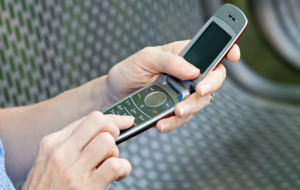A flip cover, large buttons with numbers and small letters of the alphabet, a green phone key, a red phone key, and a circular button in the middle to navigate through the menu and the few apps the device has. This is the traditional mobile phone that we have all held in our hands at some point—some for longer, others for shorter. For many years, these types of phones have continued to exist on the market, mainly targeting elderly tech customers who struggle to understand how to use a smartphone. Their functions are limited to making calls, sending messages, and occasionally having an alarm clock and a very simple camera.
These mobile phones, which cannot be compared to the advanced Android and iOS software, seem to offer something that the other “smart” phones cannot. An increasing number of people who embrace a slower pace of life seem to be adopting these devices, choosing to sacrifice certain digital conveniences for the peace and well-being that a flip phone with buttons and five basic functions can provide. Their motivation? The desire to regain their well-being, reconnect with the real world, and escape the claws of constant connectivity.
What does a traditional mobile phone offer me?
In recent years, smartphones have become our constant companions. They provide access to everything, from social media to banking, entertainment, and work emails—all in the palm of our hands. In an age where our lives are intertwined with the digital world, the idea of abandoning an iPhone for a flip phone seems almost unthinkable. However, this convenience comes at a price. Studies have shown that excessive screen time, especially on smartphones, can contribute to anxiety, depression, and a reduction in personal interactions. The need to stay connected 24/7 can become overwhelming, leaving people feeling mentally exhausted and socially isolated.
This is where the flip phone comes in, a symbol of simpler times designed for basic functionality, unlike smartphones. There is no endless scrolling, no notifications sounding every few seconds, and no apps designed to keep us glued to the screen. For those seeking a break from the constant bombardment of information, flip phones appear to offer an ideal digital detox.
Cost is also an important factor, as a significant portion of consumers find the price of most smartphones prohibitive. Thus, while some people are willing to spend up to €2,000 for a mobile phone, others prefer to pay €100 for a device that does just what its name suggests: make calls.
Ask me anything
Explore related questions





